Quartz is one of the most abundant minerals on Earth, widely recognized for its beautiful clarity and energetic properties. Over the years, countless unique names have been attributed to quartz crystals, such as Azeztulite, Anandalite, Satyaloka Quartz, Agnitite, Amazez, Amaranthine, Auralite, Astraline, Vitalite, Satiya Mani and many more. These names are often created by individuals or groups who imbue the crystals with specific spiritual energies or give them energetic meanings because of the specific location. However, it is important to understand that these are not distinct minerals but are simply varieties of quartz.
Quartz vs. Glass: Key Differences

Slag glass, often marketed as real quartz, is a byproduct of industrial metal smelting. It is made by melting and cooling leftover materials from the metal manufacturing process. While its appearance can mimic natural quartz or other minerals with vibrant and varied colors, it is entirely man-made and has no crystalline structure. Most slag glass is produced in China due to the low cost of production.
Slag glass is frequently used to deceive uninformed buyers, particularly in countries like Egypt and other regions where tourism thrives, being sold as "authentic local crystals." Its production cost is extremely low, making it a lucrative product for sellers. It is not uncommon to see these pieces passed off as amethyst, quartz, or other valuable minerals, but they lack the defining characteristics of real crystals.
To identify slag glass, look for uneven or unnatural coloring, air bubbles within the material, and a lack of natural crystal shapes and broken edges that look like broken glass edges. Quartz breaks differently. Buyers should be cautious, as slag glass can easily be mistaken for genuine quartz by those unfamiliar with crystals and minerals.
While both quartz and glass may look similar, especially in polished forms, their internal structures and origins set them apart. Quartz is renowned for its energetic properties due to its crystalline structure, while glass is valued more for its aesthetic qualities and versatility.
Marketing Quartz with Spiritual Names
Many sellers in the crystal market capitalize on the spiritual and energetic appeal of quartz by assigning it unique names and claiming enhanced properties. For example:
While these names add an aura of mystique, it is crucial to recognize that the underlying material is still quartz. The perceived special qualities often stem from the programmed energy or intention of the seller rather than any inherent uniqueness in the crystal itself. For example the Satyaloka quartz was found in Tamil Nadu, near Nemam, where the old temple of Amma and Bhagavan is located. These are spiritual teachers from the oneness university of south India that gave in the old days dikshas that would elevate ones consciousness and the energy was very strong. Someone creative came up with the idea of collecting some quartz found around this temple and sell it as satyaloka quartz. Another crystal called Azeztulite is a quartz found in the USA where HeavenandEarthJewelry got their hands on it and programmed / energised it with a beautiful story. Know that any of these quartz crystals will loose their programmed energies if put inside a quantum block or inside an EoE generator. These systems will override any programming.
Conclusion
Understanding the difference between quartz and glass, and being aware of the marketing tactics used to sell quartz under unique names, empowers buyers to make informed decisions. Whether you are drawn to quartz for its natural beauty, metaphysical properties, or spiritual significance, remember that its true value lies in its timeless and universal essence.

Moldavite is a natural glass formed from the heat of a meteorite impact approximately 15 million years ago in the Czech Republic. Its unique green hue and extraterrestrial origin make it highly sought after. While genuine moldavite is prized, fake moldavite made from green glass is common in the market. Its spiritual appeal includes transformation and connection to higher realms and even though it is glass, this is a very spiritual form of glass.

Mystic quartz is not a naturally occurring stone but rather a color-enhanced quartz with a thin titanium coating applied to create its rainbow-like effect. Though beautiful, it is sold as a “mystical” crystal, but its properties are not inherent; it is regular quartz artificially altered to appeal to buyers seeking unique stones.

Tektites are natural glass formed during meteorite impacts. These black or dark-colored glassy objects are found in various regions worldwide, such as Southeast Asia and Australasia. Their extraterrestrial origin and mysterious energy are often marketed as powerful tools for meditation and spiritual growth.

Trinitite is the glassy crystal residue left on the desert floor after the plutonium-based Trinity nuclear bomb test on July 16, 1945, near Alamogordo, New Mexico. The glass is primarily composed of arkosic sand composed of quartz grains and feldspar (both microcline and smaller amount of plagioclase with small amount of calcite, hornblende and augite in a matrix of sandy clay) that was melted by the atomic blast. In 1953 it was bulldozed and buried by the United States Atomic Energy Commission. It is now illegal to take the remaining material from the site; however, material that was taken prior to this prohibition is still in the hands of collectors. Buyers should beware of modern reproductions or fake trinitite marketed as genuine.
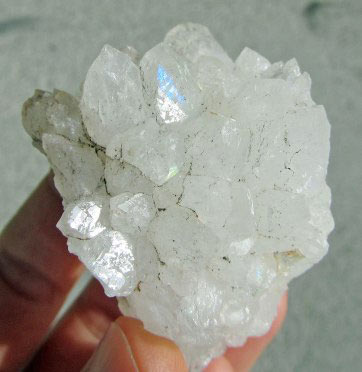
Anandalite is simply quartz with an iridescent sheen caused by natural inclusions or treatments. It is often marketed as a powerful spiritual crystal for awakening joy and higher consciousness. However, it is regular quartz.

Satya-Mani Quartz is another name for quartz marketed with spiritual connotations. Its name, meaning "truth gem," is often linked to meditation and spiritual truth, but it is still standard quartz. Sellers energize it to add perceived value for spiritual practices.

Super-7, or “Melody’s Stone,” is a mix of quartz varieties such as amethyst and smoky quartz, combined with minerals like cacoxenite and rutile. It is said to carry the combined properties of all its components, but its spiritual appeal is primarily a marketing strategy. It is visually striking and popular in metaphysical circles.

Opalite is a man-made glass that mimics the opalescent appearance of opal. It is inexpensive and commonly marketed as a mystical or calming crystal, but it holds no natural mineral origin. Buyers should be aware it is purely artificial, despite its enchanting look.
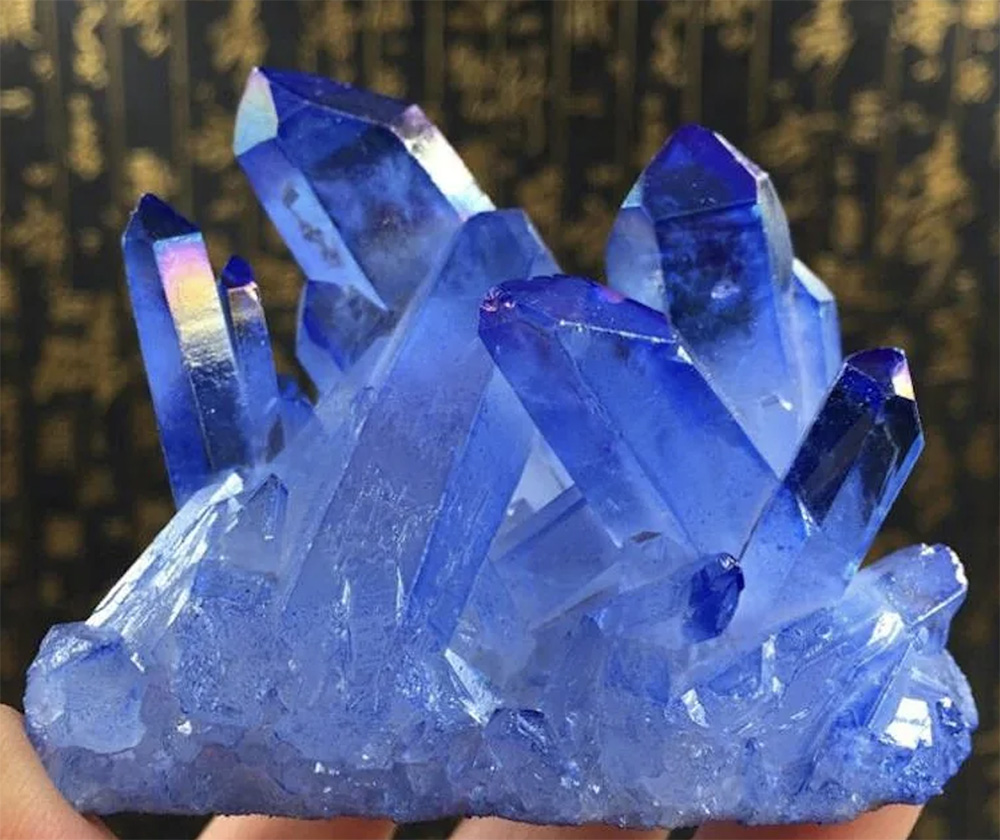
Siberian Blue Quartz is a lab-created material with a deep blue color. Often sold as a spiritual crystal, it is artificially crafted and has no relation to natural quartz. While visually appealing, its value lies only in its aesthetic and synthetic origin.

Goldstone is a man-made glass with metallic inclusions, giving it a glittering effect. It was first created in 17th-century Italy and is marketed as a prosperity or ambition stone. Despite its beauty, it is not a natural mineral and is purely ornamental.

Gaia Stone is a bright green glass created from volcanic ash left over from the eruption of Mount St. Helens in Washington State in 1980. It is a man-made material derived from natural volcanic components and is prized for its vibrant color and connection to a historic geological event.

Obsidian is a natural volcanic glass formed when lava cools rapidly without crystallizing. It is commonly found in regions with volcanic activity, such as the western United States, Iceland, and Japan. Its smooth, glassy texture and deep black color make it highly recognizable.

Nirvana Quartz, also known as Himalayan Ice Quartz, is a naturally formed quartz found high in the Himalayan mountains of India. It is characterized by its irregular, etched surfaces formed due to glacial activity. This quartz is often clear or pinkish in color.
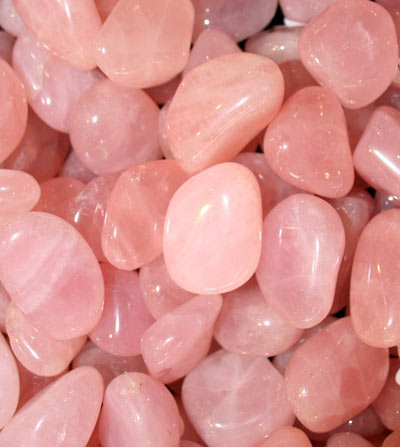
Rose Quartz is a pink variety of quartz commonly found in Brazil, Madagascar, and South Dakota, USA. Its pink hue is due to trace amounts of titanium, iron, or manganese. This mineral forms in massive structures rather than distinct crystals.

Aqua Aura is quartz that has been coated with a thin layer of gold to produce its vibrant iridescent blue sheen. The coating is applied using a process called vapor deposition, bonding the gold atoms to the quartz at high temperatures.

Citrine is a yellow-to-orange variety of quartz primarily found in Brazil, Madagascar, and Spain. Its color results from trace amounts of iron within the quartz. Natural citrine is rare, and much of what is sold is heat-treated amethyst.

Agate is a form of chalcedony, a microcrystalline variety of quartz. It is found worldwide, often in volcanic rock cavities, and is known for its layered bands of color. Common sources include Brazil, Uruguay, and the United States.

Aventurine is a form of quartz characterized by its shimmering or glittery effect, known as aventurescence. This effect is due to tiny inclusions of minerals like mica or hematite. Aventurine is commonly found in India, Brazil, and Russia.

Golden Healer Quartz is a quartz crystal with a natural coating of iron oxide that gives it a golden-yellow hue. It is typically found in regions with significant iron deposits, such as Brazil and Arkansas, USA.

Herkimer Quartz, often referred to as Herkimer Diamonds, are doubly terminated quartz crystals found primarily in Herkimer County, New York. Their clarity and natural faceting make them distinctive among quartz varieties.
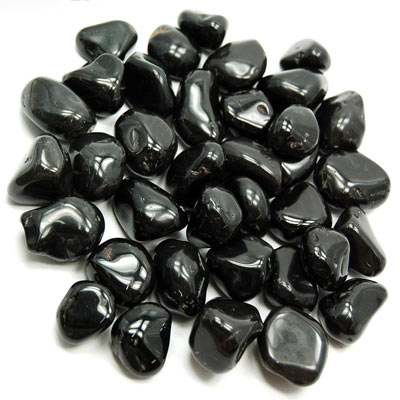
Onyx is a variety of chalcedony, a microcrystalline quartz, with parallel banding. It is typically black but can have white or other colored bands. Onyx forms in volcanic lava and is commonly found in regions like Brazil, India, and the United States.

Tiger Eye is a variety of quartz with a fibrous structure that gives it a chatoyant (cat’s eye) effect. It is formed when quartz replaces crocidolite, a blue asbestos mineral. Found primarily in South Africa and Western Australia, it is known for its golden-brown sheen.

Chalcedony is a cryptocrystalline form of quartz composed of microscopic quartz crystals. It is often found in volcanic rocks or weathered basalt. Chalcedony comes in a range of colors and is found worldwide, with notable sources in Turkey, Brazil, and Namibia.

Bloodstone, also known as heliotrope, is a variety of chalcedony with red spots caused by iron oxide inclusions. Found in India, Brazil, and Australia, it typically occurs in sedimentary rocks and is associated with deposits of jasper and agate.
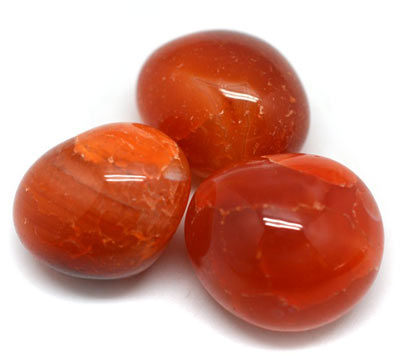
Carnelian is an orange to reddish-brown variety of chalcedony, colored by iron oxide inclusions. It is commonly found in Brazil, Uruguay, and India, forming in volcanic rocks and cavities. Carnelian has been used historically in carvings and jewelry.

Jasper is an opaque variety of quartz known for its vibrant colors and patterns caused by mineral impurities. It forms in volcanic ash or sedimentary deposits. Major sources include Madagascar, Australia, and the USA. Its patterns make it highly collectible.
Here is a list of some of the names given to the most common mineral on earth, Quartz - so do not be fooled:
(bold are the most familiar ones and green is technically not a quartz but same chemical layout and italic is something extra inside quartz)
| Agate | Cactus Quartz | Ice quartz (Nirvana quartz) | Quartz |
| Agnitite | Canary stone | Illuminite (with calcite) | Quetzalitztli |
| Ajoite (inside quartz) | Cape May Diamond | Indochinite (glass) | Quartzine |
| Amarillo Stone | Capped Quartz | Irghizite (glass) | Rainbow Obsidian (glass) |
| Amazez | Carnelian | Iris Agate | Rainforest Jasper |
| Amberine | Cathedral quartz | Iris Quartz | Rathbunite |
| Amegreen | Celestial quartz | Irnimite | Revelation stone |
| Ametrine | Chalcedony | Ivorite (glass) | Riband Agate |
| Amethyst | Chert | Jasper | Ribbonstone |
| Amphibole quartz | Chinite (glass) | Jacinto de Compostela Quartz | Snowflake obsidian (glass) |
| Amulet stone | Chrysojasper | Fake Jade (Chinese quartz) | Rock Crystal |
| Anandalite | Circle stone | Keatite | Rose quartz |
| Andara (glass) | Citrine | Keystonite Chalcedony | Rosophia (mainly quartz) |
| Angel aura | Clear Lake Diamond | Kinradite | Rutilated quartz |
| Angel phantom quartz | Cloud Agate | Konilite | Russian Red Quartz |
| Angeline | Coesite | Laguna Agate | Sagenite |
| Apache tears (glass) | Conite | Lake Superior Agate | Sard |
| Apricotine | Cotterite | Laser Wand | Sardonyx |
| Aqua Aura | Creolite | Lavendine | Satyaloka quartz |
| Aquaprase | Cristobalite | Lazurine | Satya Mani |
| Aqua Lemuria | Cubosilicite | Lechatelierite | Sedonalite |
| Arkansas Candle | Dallasite | Lemurian seed crystals | Scepter Quartz |
| Auralite | Damsonite | Lithium quartz | Schwimmstein |
| Australite (glass) | Darlingite | Lodolite | Seftonite |
| Aventurine | Darwinite (glass) | Mahogany Obsidian (glass) | Seifertite |
| Azeztulite | Dendritic Agate | Mani stone | Seriphos |
| Azurchalcedony | Dragonite | Manifest light crystals | Shantilite |
| Azozeo | Dreamstone | Mecca stone | Shiva Lingam |
| Azumar (mostly quartz) | Dream quartz | Merlinite | Shocked Quartz |
| Azurchalcedony | Diackethyst | Mocha Stone | Siberian blue |
| Babel-Quartz | Dotsero Diamond | Mogánite | Sichuan Quartz |
| Basanite | Dragonite | Moldavite (glass) | Smoky quartz |